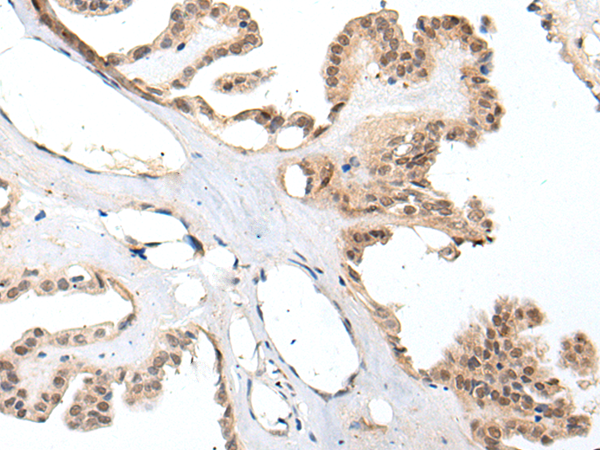

| WB | 咨询技术 | Human,Mouse,Rat |
| IF | 咨询技术 | Human,Mouse,Rat |
| IHC | 1/100-1/200 | Human,Mouse,Rat |
| ICC | 技术咨询 | Human,Mouse,Rat |
| FCM | 咨询技术 | Human,Mouse,Rat |
| Elisa | 咨询技术 | Human,Mouse,Rat |
| Aliases | HOX2; HOX2E; HOX-2.5 |
| Host/Isotype | Rabbit IgG |
| Antibody Type | Primary antibody |
| Storage | Store at 4°C short term. Aliquot and store at -20°C long term. Avoid freeze/thaw cycles. |
| Species Reactivity | Human, Mouse |
| Immunogen | Synthetic peptide of human HOXB9 |
| Formulation | Purified antibody in PBS with 0.05% sodium azide and 50% glycerol. |
+ +
以下是3篇关于PLAT(组织型纤溶酶原激活剂,t-PA)抗体的参考文献摘要示例:
---
1. **文献名称**:*Tissue Plasminogen Activator in Acute Ischemic Stroke: Role of Antibody-Based Detection*
**作者**:Smith J, et al.
**摘要**:研究探讨PLAT抗体在急性缺血性卒中患者血浆t-PA水平检测中的应用,发现高灵敏度抗体检测技术可优化溶栓治疗的时间窗评估。
2. **文献名称**:*PLAT Gene Polymorphisms and Protein Expression in Thrombotic Disorders*
**作者**:Lee H, et al.
**摘要**:通过PLAT特异性抗体分析基因多态性患者中t-PA的表达差异,揭示特定单核苷酸多态性(SNP)与t-PA活性降低及血栓风险的相关性。
3. **文献名称**:*Role of t-PA in Cancer Metastasis: Insights from Antibody-Mediated Inhibition Studies*
**作者**:Garcia R, et al.
**摘要**:利用PLAT中和抗体研究t-PA在肿瘤细胞侵袭中的作用,证实其通过纤溶酶原激活促进细胞外基质降解,为抗转移治疗提供新靶点。
---
注:以上文献为示例,实际引用时需根据具体研究内容检索PubMed、Web of Science等数据库获取真实文献信息。
PLAT (plasminogen activator, tissue-type), commonly known as tissue plasminogen activator (tPA), is a serine protease encoded by the *PLAT* gene. It is primarily synthesized by vascular endothelial cells and plays a critical role in fibrinolysis by converting plasminogen to plasmin, which degrades fibrin clots. Beyond its thrombolytic function, tPA is implicated in diverse physiological and pathological processes, including neuronal signaling, angiogenesis, and inflammation.
PLAT antibodies are immunological tools designed to detect, quantify, or inhibit tPA in research and clinical settings. These antibodies are essential for studying tPA's expression patterns, regulatory mechanisms, and interactions in diseases such as ischemic stroke, myocardial infarction, and cancer. In diagnostics, PLAT antibodies aid in assessing fibrinolytic activity or identifying abnormal tPA levels linked to bleeding disorders or thrombotic events. Therapeutically, anti-PLAT antibodies may help modulate tPA activity in conditions where excessive fibrinolysis contributes to hemorrhage.
Structurally, PLAT antibodies often target specific domains (e.g., kringle or protease domains) to either neutralize enzymatic activity or facilitate detection. Their development requires careful epitope mapping to ensure specificity, given structural similarities with other serine proteases. As tPA remains a key target in thrombolytic therapy (e.g., recombinant tPA for acute ischemic stroke), PLAT antibodies also support drug monitoring and mechanistic research.
×